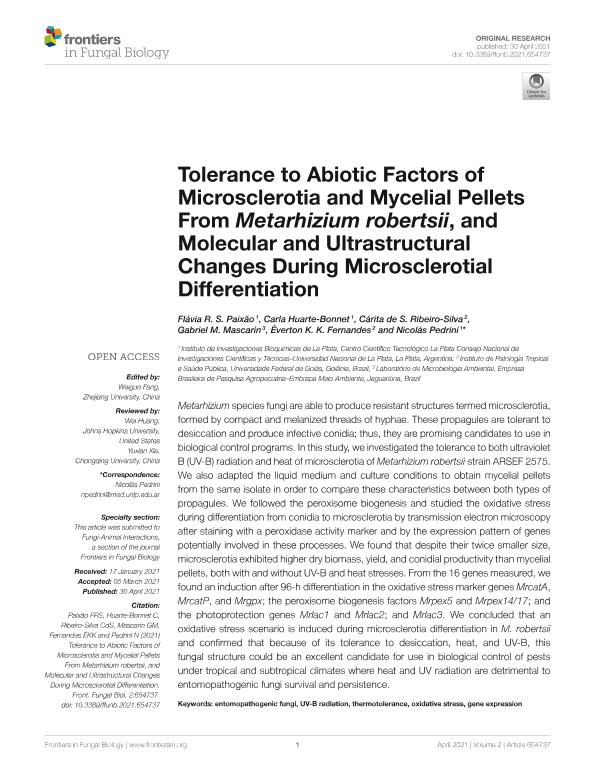Artículo
Tolerance to Abiotic Factors of Microsclerotia and Mycelial Pellets From Metarhizium robertsii, and Molecular and Ultrastructural Changes During Microsclerotial Differentiation
Paixão, Flávia R. S.; Huarte Bonnet, Carla ; Ribeiro-Silva, Cárita de S.; Mascarin, Gabriel M.; Fernandes, Éverton; Pedrini, Nicolás
; Ribeiro-Silva, Cárita de S.; Mascarin, Gabriel M.; Fernandes, Éverton; Pedrini, Nicolás
 ; Ribeiro-Silva, Cárita de S.; Mascarin, Gabriel M.; Fernandes, Éverton; Pedrini, Nicolás
; Ribeiro-Silva, Cárita de S.; Mascarin, Gabriel M.; Fernandes, Éverton; Pedrini, Nicolás
Fecha de publicación:
04/2021
Editorial:
Frontiers Media
Revista:
Frontiers in Fungal Biology
e-ISSN:
2673-6128
Idioma:
Inglés
Tipo de recurso:
Artículo publicado
Clasificación temática:
Resumen
Metarhizium spp. fungi are able to produce resistant structures termed microsclerotia, formed by compacted and melanized threads of hyphae. These propagules are tolerant to desiccation and produce infective conidia, thus they are promising candidates to use in biological control programs. In this study, we investigated the tolerance to both UV-B radiation and heat of microsclerotia of M. robertsii strain ARSEF 2575. We also adapted the liquid medium and culture conditions to obtain mycelial pellets from the same isolate in order to compare these characteristics between both types of propagules. We followed the peroxisome biogenesis and studied the oxidative stress during differentiation from conidia to microsclerotia by transmission electron microscopy after staining with a peroxidase activity marker, and by the expression pattern of genes potentially involved in these processes. We found that despite their twice smaller size, microsclerotia exhibited higher dry biomass, yield, and conidial productivity than mycelial pellets, both with and without UV-B and heat stresses.. From the sixteen genes measured, we found an induction after 96-h differentiation in the oxidative stress marker genes MrcatA, MrcatP, and Mrgpx, the peroxisome biogenesis factors Mrpex5 and Mrpex14/17, and the photoprotection genes Mrlac1, Mrlac2, and Mrlac3. We concluded that an oxidative stress scenario is induced during microsclerotia differentiation in M. robertsii, and confirmed that due to its tolerance to desiccation, heat, and UV-B, this fungal structure could be an excellent candidate for use in biological control of pests under tropical and subtropical climates where heat and UV radiation are detrimental to entomopathogenic fungi survival and persistence.
Palabras clave:
ENTOMOPATHOGENIC FUNGI
,
UV-B RADIATION
,
THERMOTOLERANCE
,
OXIDATIVE STRESS
Archivos asociados
Licencia
Identificadores
Colecciones
Articulos(INIBIOLP)
Articulos de INST.DE INVEST.BIOQUIMICAS DE LA PLATA
Articulos de INST.DE INVEST.BIOQUIMICAS DE LA PLATA
Citación
Paixão, Flávia R. S.; Huarte Bonnet, Carla; Ribeiro-Silva, Cárita de S.; Mascarin, Gabriel M.; Fernandes, Éverton; et al.; Tolerance to Abiotic Factors of Microsclerotia and Mycelial Pellets From Metarhizium robertsii, and Molecular and Ultrastructural Changes During Microsclerotial Differentiation; Frontiers Media; Frontiers in Fungal Biology; 2; 12; 4-2021; 1-12
Compartir
Altmétricas



